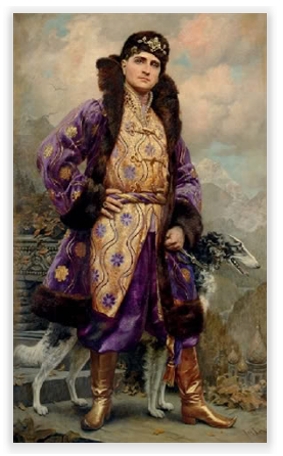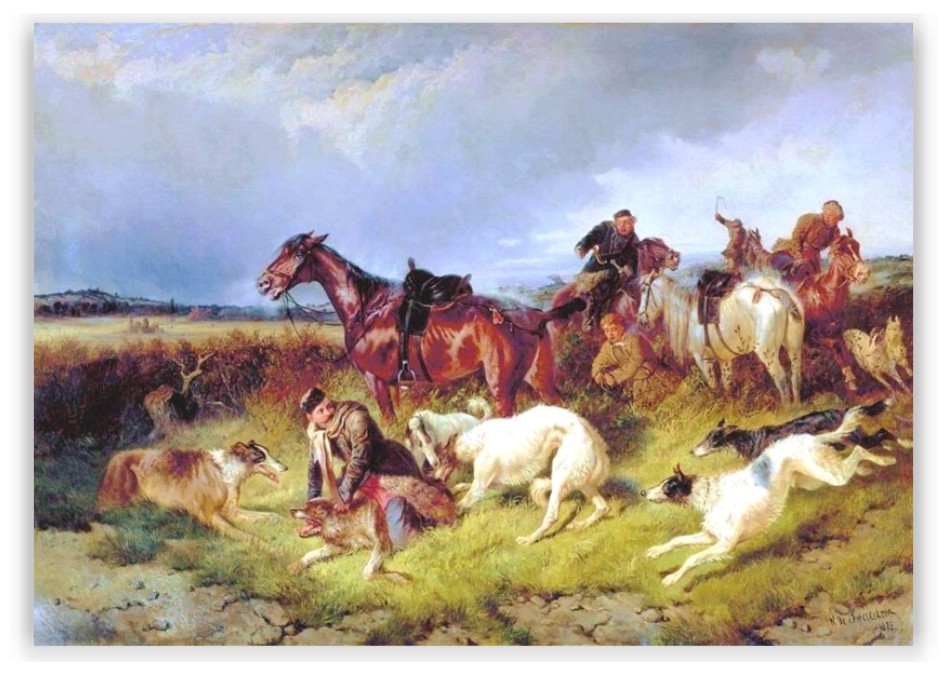History of the Borzoi ...
The origin of the Borzoi is fairly ancient dating back to early centuries of Russian history. Before the first Czar, the Grand Dukes and provincial aristocrats kept coursing hounds for sport and to protect their stock from wolf attacks. One of the earliest written records of the Borzoi exists in a letter from the Grand Duke of Novgorod to his son in 1260 explaining the requirements for a good coursing hound. This letter is now in the Leningrad Museum.
Because of the vast size of Russia, local types of Borzoi developed according to the breeder selection, the local terrain and type of game hunted. Two main types were the ancient strain of Northern Russia, used predominantly on hare so that they were of fine build and very fast, and the lowland Borzoi of heavier build and used to hunt wolves. These two types were bred together to obtain an all purpose Borzoi capable of coursing various game, and the Psovi or long coated Borzoi of medium build was produced.
The Borzoi were used in matched pairs or teams to run down the wolf which was always given a good head start by the sporting Russians. When alongside, the Borzoi took a grip behind the wolf's ear and flipped it onto its back, keeping it pinned to the ground until the hunter arrived. In the case of smaller game such as fox or hare, the Borzoi would flip the game and squeeze the chest for a quick kill. Borzoi do not tear the game and for this reason are still used in Russia today, as they do not damage the pelts as do traps.
In 1650, a detailed description of the breed was published and it is surprisingly close to the present standard. Like the Greyhound in England of the Middle Ages, the Borzoi was the sole prerogative of the Russian aristocracy. If a peasant dared to touch one without permission, he was put to death.
The Borzoi were held in such esteem that they could only be given as gifts to other royalty or sometimes exchanged for country estates. On one occasion in the recent 1800s a "princess of the blood" was given in marriage to an elderly hunter in exchange for a Borzoi. However the descendants dispute this. They claim grandmama was exchanged for TWO Borzoi!During the long centuries of serfdom in Russia, the nobles maintained huge estates and kept Borzoi by the hundreds. Everything was done on a vast and lavish scale. Only the very best of the hounds were bred from and the purity of the breed was jealously maintained.
Prized Borzoi often had personal servants to cater for their needs and the dogs were housed and fed better than most of the population. When serfdom was finally abolished in 1861, many nobles could not afford to continue in their previous lifestyle. The huge estates were broken up, the kennels disbanded and the Borzoi fell on hard times, with only a few of the richer nobles and enthusiasts keeping the breed going.
In 1873, Count Scheremityeff founded the "Imperial Association for the Propagation of Hounds and Regulation of Hunting" in an attempt to preserve the Borzoi in its native country. The first Borzoi show was held that year in Moscow and generated a great deal of enthusiasm for the breed.
Although the Borzoi existed in Russia for centuries as a prized coursing hound, nothing of the breed was known in the British Isles until two Englishmen wrote of their travels in Russia in 1812. Strangely enough, England still seemed to ignore the Borzoi until a pair were given by the Czar to Queen Victoria nearly twenty years later. The Prince of Wales (later King Edward) was an avid hunter and took over the breed of the Queen's Borzoi so that they spread through the ranks of the English aristocracy. The Duchess of Manchester showed the first Borzoi in 1863, the Duchess of Newcastle became an advocate of the breed and Queen Alexandra owned one of the earliest English champions.As show dogs, Borzoi reached a peak of popularity from the late 1880s through to the 1920s and 30s. They appear regularly in Art Nouveau, Art Deco, Vogue magazines and in the company of the stars of the silent movies - Jean Harlow, Sarah Bernhardt, Mae West etc. The Duchess of Newcastle founded her kennel in 1891 when the Czar and his uncle the Grand Duke Nicholas sent 20 Borzoi to Crufts and auctioned them off after the show. These dogs sold for prices far in excess of an annual salary which ensured that only the aristocracy or the very wealthy could afford them. In 1892 a second shipment of 20 Borzoi were sent to Crufts and the boom period began. A few other imports arrived on special consignment from Russia and for a while there was a choice of nearly 60 Russian imports to establish the breed in England - what bliss for breeders!
Europe has always been the stronghold for Borzoi as show dogs. At the outbreak of the Russian Revolution, a few dedicated breeders from Germany, Belgium and Holland took great personal risk in going to Russia to rescue breeding stock from the best kennels. Considering this was also in the middle of the First World War, it is not surprising that one man was wounded and a number of dogs shot while trying to smuggle them across the borders. Still, at least 17 Borzoi from the famed Perchino and Woronzova hunts were saved to appear in European show rings and pedigrees. Even today, the main champion lines of England and Europe go back in direct male descent from Ch. Asmodey Perchino (Imp Russia) who was also the model for the FCI standard of the breed.
Australia's first imports came direct from the Czar in 1898 and were quarantined in the Melbourne Zoo. Australia was generally too hot for Borzoi hunts except in Winter, and crossbreeds known as `kangaroo dogs' were more popular, though a few hunters in cooler Victoria continued to keep Borzoi for coursing kangaroos until the 1950s.
A well made Borzoi is fast, agile and ready to run forever if the weather is suitable and the mood takes them. They will chase anything that moves, but it seems that a real hunt brought out the truly dedicated hunter. There is a case on record of a Russian bitch coursing a wolf for 13 miles. She seemed slower than usual and missed her first lunge but would not give up until she caught her wolf. The bitch then went off to dig a hole in the snow where she whelped an unexpected litter of 5 pups. No wonder she was slower than usual!


